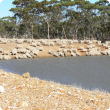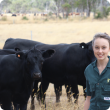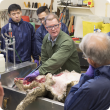Beef cattle
The Western Australian beef herd consists of approximately two million head, half of which free range on extensive pastoral stations in the northern rangelands while the remainder roam the lush pastures of the agricultural region of the south and south-west of the state.
In 2011/12 the Australian Bureau of Statistics estimated the gross value of beef production in WA at $517 million. The state exported some 220 000 live cattle valued at $154 million in addition to 99 000 tonnes of boxed beef products worth $68 million in 2012.
The Department of Primary Industries and Regional Development's current focus is on new and diversified market opportunities for WA live cattle exports and beef products. The department provides support to develop enduring supply chain relationships through effective communication, business model change and market development.
Filter by search
Filter by topic
- (-) Remove Pests, weeds & diseases filter Pests, weeds & diseases
- (-) Remove Sheep filter Sheep
- Livestock disease surveillance (14) Apply Livestock disease surveillance filter
- Diseases (14) Apply Diseases filter
- Livestock health & diseases (14) Apply Livestock health & diseases filter
- Biosecurity & quarantine (14) Apply Biosecurity & quarantine filter
- Biosecurity (14) Apply Biosecurity filter
- Livestock biosecurity (12) Apply Livestock biosecurity filter
- Dairy cattle (9) Apply Dairy cattle filter
- Livestock management (7) Apply Livestock management filter
- Goats (5) Apply Goats filter
- Pigs (4) Apply Pigs filter
- Horses (4) Apply Horses filter
- Feeding & nutrition (3) Apply Feeding & nutrition filter
- Control methods (3) Apply Control methods filter
- Mechanical, physical and cultural (2) Apply Mechanical, physical and cultural filter
- Management & reproduction (2) Apply Management & reproduction filter
- State Barrier Fence (2) Apply State Barrier Fence filter
- Invasive species (2) Apply Invasive species filter
- Emergency animal disease preparedness (2) Apply Emergency animal disease preparedness filter
- Poultry & birds (1) Apply Poultry & birds filter
- Preventing residues (1) Apply Preventing residues filter
- Residues in livestock (1) Apply Residues in livestock filter
- Pests (1) Apply Pests filter
- Stockfeed (1) Apply Stockfeed filter
- Export services (1) Apply Export services filter
- Chemicals (1) Apply Chemicals filter
- Food, export & investment (1) Apply Food, export & investment filter
- Pest animals (1) Apply Pest animals filter
- Pest mammals (1) Apply Pest mammals filter






